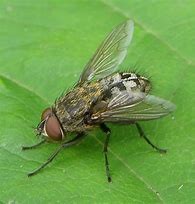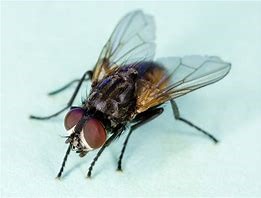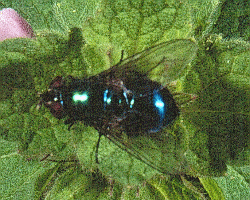Connecticut Pest Control : A closer look at Cluster Flies aka Attic Flies
Cluster flies are large black colored flies, scientifically known as ‘Pollenia rudis’, and often show up in homes from late fall through early spring. These flies can cause much confusion, the cluster fly is very similar in appearance to a house fly as well as being ‘kissing cousins’ genetically to the bottle or blow fly.
Cluster flies are also known as attic flies. This name describes its behavioral characteristics very well, the tendency of clustering in large numbers inside attics. Unlike blow flies, however, cluster flies do not reproduce indoors so homeowners do not have to worry about the flies originating from a dead animal carcass or any other unpleasant material located within the attic or walls.
Cluster flies emerge in the summer or autumn. Often in large numbers, they enter houses to find some warm places where they can hibernate. These flies do not bite humans and interestingly, are strictly parasitic on earthworms.
Cluster Fly Fact Sheet:

Let us consider some important facts about cluster flies:
Physical Appearance:
The physical appearance of a cluster fly closely resembles the house or a bottle fly. Adult cluster flies are dark gray in color and about 1/3 inch long. They have yellowish golden hairs on their thorax (chest). The abdomen of a cluster fly has a prominent dark and light-colored checkered pattern.
Unlike house flies they do not have dark stripes on their thorax and do not exhibit bluish or greenish metallic colored bodies like bottle flies. At rest, both the wings of a cluster fly overlap across the abdomen.
Cluster flies have been known to release a sickly, sweetish odor, often likened to buckwheat honey if disturbed. Another important feature of cluster flies is that they are slow and sluggish.
Living Patterns and Characteristics:
As soon as the fall approaches, cluster flies begin to enter homes and buildings in large numbers. At this time of the year, the days become shorter and the temperature begins to fall, hence they enter houses in search for overwintering sites. During this time of the year, the west and south facing buildings are exposed to more sunlight, so cluster flies are attracted more to such buildings due to their warmth they seek. They enter these buildings through small openings or cracks and crevices near window or door frames, open or unscreened windows/vents.
Once inside they gather in an isolated, safe place such as attics or false (drop) ceilings and begin to hibernate. Once the temperature begins to constantly exceed 55o F, they become active. However, if the temperature inside the building is manually controlled and exceeds this threshold of 55o, cluster flies may come out falsely reacting as if it were spring. Or at least on the sunny sides of the structures. Cluster flies are strongly attracted to light, so you can also find them near windows and near lamps at night.
Feeding Tendencies:
Cluster flies are not harmful to property, they enter buildings in the autumn simply to simply hibernate and nothing else. They do not have biting mouth parts like horse flies or gnats. Unlike blow flies cluster flies are not associated with animal carcass, feces, or woolen articles.
Cluster flies are strictly parasitic on earthworms. After hatching from eggs, the cluster fly larvae find and burrow into the body of an earthworm to feed. The worm typically is sacrificed during this process.
Life Cycle:
Generally, there are at least 3 to 4 generations of cluster flies per season. The beginning of a typical cluster fly lifecycle begins after the adults leave their over-wintering sites in the spring and lay eggs on the soil that contains earthworms. The eggs are mostly laid in soil cracks.
After 3 – 4 days these eggs hatch and the maggots (larvae) enter the body cavities of earthworms. These larvae then feed on the host earthworms for few days. The maggot stage in cluster flies lasts in about 13 to 22 days.
After this stage they molt and morph into the next developmental stage (pupa) in the soil. The pupal stage lasts 11 – 14 days after which adult flies come out and are ready to start the cycle again. The total lifecycle of a cluster fly is of 30 – 50 days.
Damages:
- Cluster flies are predominantly considered a nuisance because of their habit of hibernating inside homes. However, they do not cause any damage.
- These flies sometimes leave tiny dark-colored spots of excrement on walls or windows, but these spots are not known to carry any human disease-causing organisms.
- Cluster flies may exude a sickly-sweet odor when disturbed.
- Also, if these flies die in wall voids, they may attract other pests seeking food.
Difference between a House Fly, Bottle Fly and a Cluster Fly:
The cluster fly is quite different from a house or bottle/blow fly. The features below can help you to distinguish between a house or bottle fly from a cluster fly:
House Fly

Blow (Bottle) Fly

Cluster flies (1/3 inch) are larger in size than a house fly (about 1/4 inch) but smaller than a bottle fly (1/2 inch). Cluster flies are a bit darker and have dark and light checkered pattern on their abdomen which house flies or bottle flies do not possess.
Cluster flies have short yellow or golden colored hairs on their thorax. In contrast, bottle flies can be easily distinguished from the other two types of flies, as they have a greenish or a bluish metallic colored body. Another important aspect that can differentiate between a cluster fly and a house fly is the speed of movement. House and bottle flies are lightening quick whereas cluster flies are slow and sluggish.
How to Reduce Cluster Flies:
The best way to avoid cluster flies is by mechanical exclusion. Cluster flies can enter your homes through the smallest cracks around door and window frames or through any other tiny, unsealed opening.
Contact Millette Pest Control today, we can assess your home and recommend the most effective way of reducing your cluster fly issues at your location and make other recommendations as well regarding any key areas to have sealed by a contractor as well as making your attic and other spaces least conducive for this nuisance pest.
